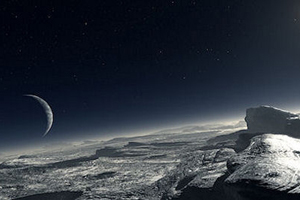 Artist's concept of a Pluto landscape, with moon Charon on
Artist's concept of a Pluto landscape, with moon Charon on
the horizon. NASA.I've been waiting for some new news from the outer reaches of our solar system. Sometimes it seems the very cold, very dark netherworld beyond Neptune is a very uneventful region. Things move more slowly, the Sun's dim light only tickles the frigid atoms and molecules out there, and being so far removed from our robotic and telescopic scrutiny, we don't see much to begin with. But, thanks to the Hubble Space Telescope, my favorite dwarf planet, Pluto, is on the horizon again!
Observations of Pluto have been made by Hubble before, bringing us the most detailed images of that small world ever taken. Still, the images reveal little more than variations in shading, and in the most recent observations, some color.
The recent images show the dwarf planet from different angles, grabbed at different times as Pluto slowly rotates, once about every six days. The darker areas have been characterized as having a "molasses" color—I'm assuming that means very dark brown, as that's the color of molasses in the bottle in our kitchen.
So, is Pluto's surface oozing with syrupy sugars? First of all, nothing should be oozing at all under the temperatures Pluto routinely experiences. Since Pluto reached its closest approach to the Sun back in the 1980s—something that happens only every 248 years—temperatures have risen to their highest in our lifetimes, and are now up to about -385 degrees Fahrenheit. Yeah, minus. Global warming on Pluto….
While scientists don't yet know what the deep brown regions are, some expect it has something to do with Pluto's methane, the existence of which we've known for some time from spectroscopic measurements. Methane is a hydrocarbon—an "organic molecule"--whose chemistry is part of the basis of life on Earth.
That's not to say there's life on Pluto—but one theory about the molasses-colored patches is that it may be some sort of tar-like substance that has developed over millions of years from the Sun's weak rays interacting with Pluto's methane. Over its seasonal and orbital gyrations, Pluto's methane cycles from being frozen solid on the ground to being a gas and forming a thin atmosphere; right now that atmosphere is as thick as it's ever been in our lifetimes.
